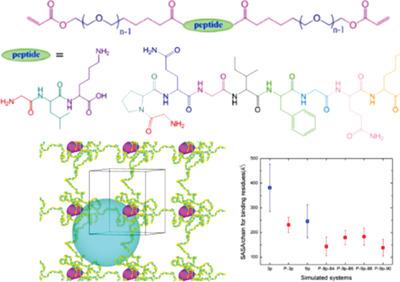当前位置:
X-MOL 学术
›
Macromol. Chem. Phys.
›
论文详情
Our official English website, www.x-mol.net, welcomes your
feedback! (Note: you will need to create a separate account there.)
An Insight into Structural and Mechanical Properties of Ideal‐Networked Poly(Ethylene Glycol)–Peptide Hydrogels from Molecular Dynamics Simulations
Macromolecular Chemistry and Physics ( IF 2.5 ) Pub Date : 2020-01-09 , DOI: 10.1002/macp.201900326 Shalini J. Rukmani 1, 2 , Dylan M. Anstine 1, 2 , Aravinda Munasinghe 2, 3 , Coray M. Colina 1, 2, 3
Macromolecular Chemistry and Physics ( IF 2.5 ) Pub Date : 2020-01-09 , DOI: 10.1002/macp.201900326 Shalini J. Rukmani 1, 2 , Dylan M. Anstine 1, 2 , Aravinda Munasinghe 2, 3 , Coray M. Colina 1, 2, 3
Affiliation

|
Simulations of local structure and interactions in stimuli‐responsive hydrogel networks at atomistic resolution has the capability to compliment experimental efforts by providing insight into current soft materials design challenges. This work simulates ideal hexafunctional networks of poly(ethylene glycol) (PEG)‐diacrylate (PEGDA) and PEG–peptide hydrogels with two enzyme‐responsive peptide sequences, Gly‐Leu‐Lys (GLK) and Gly‐Pro‐Gln‐Gly‐Ile‐Phe‐Gly‐Gln‐Lys (GPQGIFGQK), using molecular dynamics (MD) simulations at water contents from 84% to 90%. This presents the first atomistic MD study of a PEG–peptide hydrogel. The mesh sizes obtained are compared to common swelling theories and the available micropore space for diffusion is compared to the sizes of a family of matrix metalloproteinases (MMPs) to predict size‐based exclusion. The effects of interactions between PEG, peptide, and water on the chemical environment surrounding the cleaving site of peptides are investigated by examining partial radial distribution functions and solvent accessible surface areas. The chemical environment around the peptide sequence is found to be more hydrophobic in PEG‐9‐peptide hydrogels, thereby favoring cleavage by the hydrophobic binding pocket of MMPs. Furthermore, the mechanical moduli of the hydrogels is also examined, and an increase with the incorporation of peptide sequences and a general decrease with increasing water concentration is observed.
中文翻译:

从分子动力学模拟洞悉理想网络化聚乙二醇乙二醇肽水凝胶的结构和力学性能
以原子分辨率模拟刺激响应水凝胶网络中的局部结构和相互作用,能够洞察当前的软材料设计挑战,从而补充实验工作。这项工作模拟了具有两个酶响应肽序列Gly-Leu-Lys(GLK)和Gly-Pro-Gln-Gly-G的聚乙二醇(PEG)-二丙烯酸酯(PEGDA)和PEG-肽水凝胶的理想六官能网络。 Ile-Phe-Gly-Gln-Lys(GPQGIFGQK),使用分子动力学(MD)模拟在水含量从84%到90%的情况下进行。这是PEG肽水凝胶的首次原子MD研究。将获得的网孔尺寸与常见的溶胀理论进行比较,并将可扩散的微孔空间与基质金属蛋白酶(MMP)家族的尺寸进行比较,以预测基于尺寸的排阻。通过检查部分径向分布函数和溶剂可及的表面积,研究了PEG,肽和水之间的相互作用对肽裂解位点周围化学环境的影响。发现肽序列周围的化学环境在PEG-9肽水凝胶中更具疏水性,从而有利于MMPs疏水结合口袋的裂解。此外,还检查了水凝胶的机械模量,并且观察到随着肽序列的引入而增加,并且随着水浓度的增加而普遍降低。发现肽序列周围的化学环境在PEG-9肽水凝胶中更具疏水性,从而有利于MMPs疏水结合口袋的裂解。此外,还检查了水凝胶的机械模量,并且观察到随着肽序列的引入而增加,并且随着水浓度的增加而普遍降低。发现肽序列周围的化学环境在PEG-9肽水凝胶中更具疏水性,从而有利于MMPs疏水结合口袋的裂解。此外,还检查了水凝胶的机械模量,并且观察到随着肽序列的引入而增加,并且随着水浓度的增加而普遍降低。
更新日期:2020-01-09
中文翻译:

从分子动力学模拟洞悉理想网络化聚乙二醇乙二醇肽水凝胶的结构和力学性能
以原子分辨率模拟刺激响应水凝胶网络中的局部结构和相互作用,能够洞察当前的软材料设计挑战,从而补充实验工作。这项工作模拟了具有两个酶响应肽序列Gly-Leu-Lys(GLK)和Gly-Pro-Gln-Gly-G的聚乙二醇(PEG)-二丙烯酸酯(PEGDA)和PEG-肽水凝胶的理想六官能网络。 Ile-Phe-Gly-Gln-Lys(GPQGIFGQK),使用分子动力学(MD)模拟在水含量从84%到90%的情况下进行。这是PEG肽水凝胶的首次原子MD研究。将获得的网孔尺寸与常见的溶胀理论进行比较,并将可扩散的微孔空间与基质金属蛋白酶(MMP)家族的尺寸进行比较,以预测基于尺寸的排阻。通过检查部分径向分布函数和溶剂可及的表面积,研究了PEG,肽和水之间的相互作用对肽裂解位点周围化学环境的影响。发现肽序列周围的化学环境在PEG-9肽水凝胶中更具疏水性,从而有利于MMPs疏水结合口袋的裂解。此外,还检查了水凝胶的机械模量,并且观察到随着肽序列的引入而增加,并且随着水浓度的增加而普遍降低。发现肽序列周围的化学环境在PEG-9肽水凝胶中更具疏水性,从而有利于MMPs疏水结合口袋的裂解。此外,还检查了水凝胶的机械模量,并且观察到随着肽序列的引入而增加,并且随着水浓度的增加而普遍降低。发现肽序列周围的化学环境在PEG-9肽水凝胶中更具疏水性,从而有利于MMPs疏水结合口袋的裂解。此外,还检查了水凝胶的机械模量,并且观察到随着肽序列的引入而增加,并且随着水浓度的增加而普遍降低。










































 京公网安备 11010802027423号
京公网安备 11010802027423号